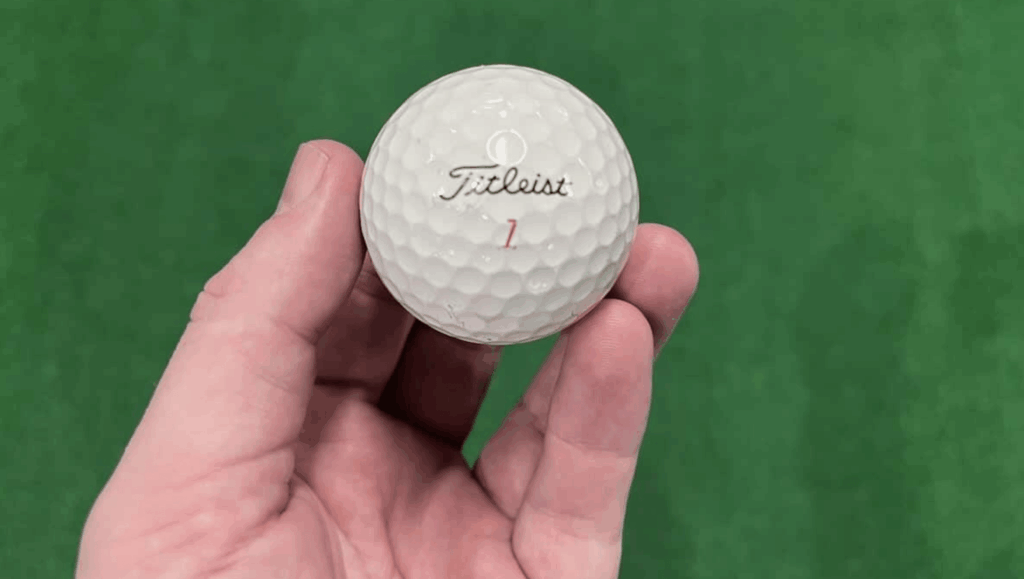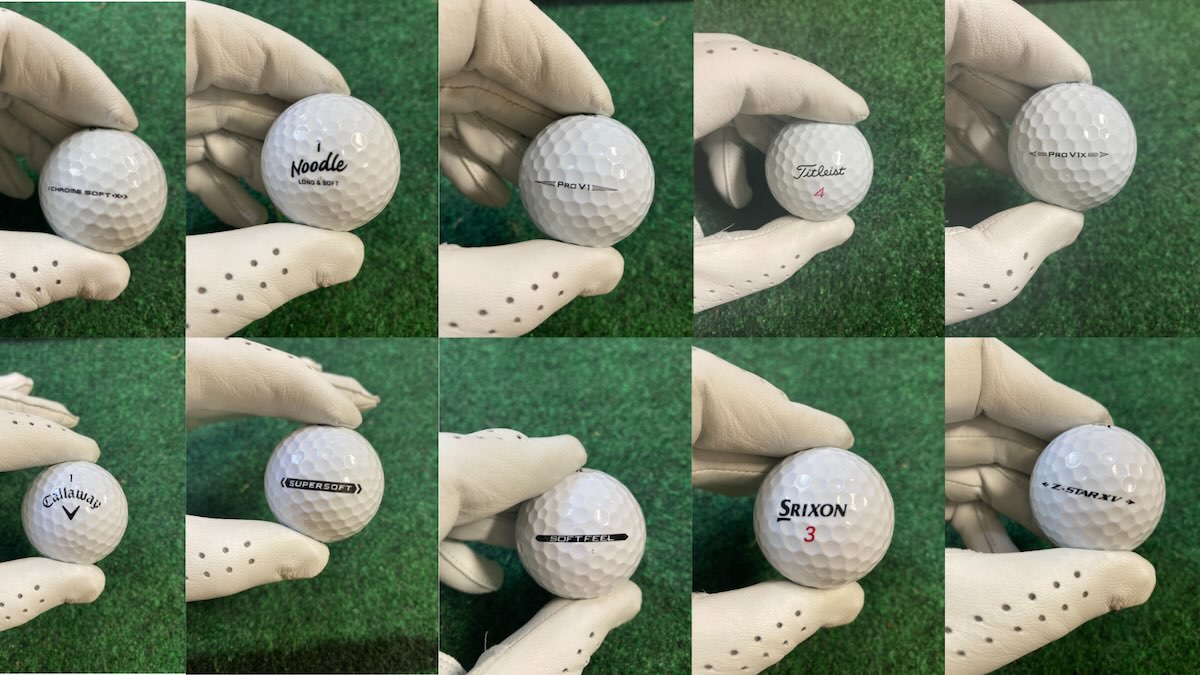The standard-size golf ball has a 1.68-inch (42.67 mm) diameter, a 5.28-inch (134.04 mm) circumference, and a 0.84-inch (21.34 mm) radius. The size of a golf ball is heavily regulated, and dimensions don’t vary much among golf ball manufacturers.
Getting to this point of optimal and fair golf ball size has been hundreds of years in the making. There are many reasons why the ball is the size it is, and after reading about it below, it will make much more sense to you why this size was chosen.
However, golf is ever-changing, and the governing bodies (USGA and R&A) are discussing changing the size again. If you’ve ever thought about how a smaller or larger ball could help, read how they will affect your swing and overall game.

Golf Ball Size Rules in 2025
As stated in the USGA and R&A rules, the parameters of a golf ball are set with limits.
- The minimum diameter is 1.68 inches
- The minimum radius is 0.84 inches
- The maximum weight is 45.93 grams
These numbers have changed over the years and could possibly change further with the introduction of the new standardized golf ball rollback plan that was recently approved. While golf balls vary slightly in size, most differences are not noticeable to the naked eye.
American vs. British Golf Balls
Prior to 1990, the R&A was allowing players to use a smaller British ball of 1.62 inches. Americans and any other non-USGA-sanctioned players were entitled to use this ball at the Open Championship.
Interestingly, the greats like Arnold Palmer and Jack Nicklaus jumped at the chance to use a smaller ball. The Tour players referred to it as the “small ball” or “British ball.” Tom Watson won the British Open three times in the 1980s; I can’t help but wonder which type of golf ball he was using.
However, in 1990, the R&A adjusted its rules to align with the USGA, so all players must use a ball with a minimum diameter of 1.68 inches.
Larger balls have been made and marketed in the past (Callaway SuperSoft Magna). However, a larger size creates more drag and does not fly as far. While it does provide more accuracy, the loss of distance is too great for most players to sacrifice.
This maximum size is inclusive of all layers, covers, and pieces. So even two and three-piece golf balls must meet the criteria set by the United States Golf Association.
Will Golf Ball Size Affect Your Game?

The size of your golf ball will affect your game no matter what level you’re at. Higher skill level players will benefit from a smaller ball to encourage maximum distance. A small ball may be hard for novice golfers to control as the accuracy is not as high as with larger balls.
For the most part, all major brands make the smallest ball allowed by the standard size rules. But if you’re looking for a larger ball, there is the aforementioned Callaway SuperSoft Magna, or if you’re lucky enough to find the old Top Flite Magnas, then go for it. Larger balls are not against the rules at all.
Pros of a Larger Golf Ball
- More accuracy on all shots
- Better ball striking
- More confidence when addressing the ball
Cons of a Larger Golf Ball
- 10-15 yards less distance on tee shots
- More challenging to make putts due to the size of the hole
- Harder to work the ball left or right
When I was younger, I experimented a lot with different golf balls and didn’t find much of a difference when using a larger ball other than the overall distance. For 10+ years, I’ve been using a Pro V1x and can’t imagine a larger ball offering a more well-rounded experience.
History of Golf Ball Size
Back in the early days of golf, around the 15th century, players used wooden balls for the game. These balls were handmade and came in all different sizes.
It wasn’t until the 17th century that the feathery ball became popular. These balls were made from tightly compressed feathers enclosed in a leather pouch. They were smaller and lighter than the wooden balls, making them easier to hit.
In 1974, the USGA introduced a new regulation that allowed golf balls to have a diameter of up to 1.68 inches but no less. This slight change was made to accommodate technological advancements in the manufacturing of golf balls, allowing for greater distance and control in a standard golf ball size.
Since then, the size regulations for golf balls have remained consistent in both recreational and professional play. However, with advances in technology and design, golf balls have become more aerodynamic, leading to greater distance and accuracy.
This has caused a bifurcation debate over whether the size regulations should be revised to challenge players and maintain the integrity of the game in tournament play.
The size of an official golf ball has gone through numerous changes throughout history, from handmade wooden balls to modern, high-tech designs. Whether you’re a casual weekend golfer or a professional player, the standards for golf ball size remain the same, keeping the game fair and consistent for all of us.
Golf Ball Size Comparison Chart
From a study in 2010 you can see how close in size golf balls truly are from a few of the top brands from that time.
| Name/Model | Diameter inch (mm) | Weight (g) |
| PGF Optima TS PLUS+ | 1.6803 (42.68) | 45.4 |
| Callaway Big Bertha | 1.6803 (42.68) | 45.2 |
| Titliest Pro V1 | 1.6799 (42.67) | 45.6 |
| Srixon AD333 | 1.6799 (42.67) | 45.4 |
| Top Flite D2 Distance | 1.6799 (42.67) | 45.5 |
| TaylorMade TP/Red LDP | 1.6799 (42.67) | 45.6 |
| Wilson Staff DX2 Soft Distance | 1.6799 (42.67) | 45.4 |
| Pinnacle Gold FX Long | 1.6799 (42.67) | 45.8 |
Source: An Experimental Study of Golf Ball Aerodynamics. 2010.
Related Articles
- What Do The Numbers on Golf Balls Mean?
- Best Amateur Golf Balls
- Best Club To Chip With Around The Green
- Best Titleist Golf Balls
Clint is PGA-certified and was a Head Teaching Professional at one of Toronto's busiest golf academies. He was also featured on Canada's National Golf TV program, "Score Golf Canada," twice. He graduated with a degree in Golf Management from the College of the Desert in California and studied under Callaway's co-founder, Tony Manzoni. He has a handicap index of 6.2 and spends the winters near Oaxaca, Mexico, where he plays twice a month at the Club de Golf Vista Hermosa. He's written over 100 articles at GolfSpan since 2021. You can connect with Clint at LinkedIn, FB, his website, or Clintcpga@gmail.com.







